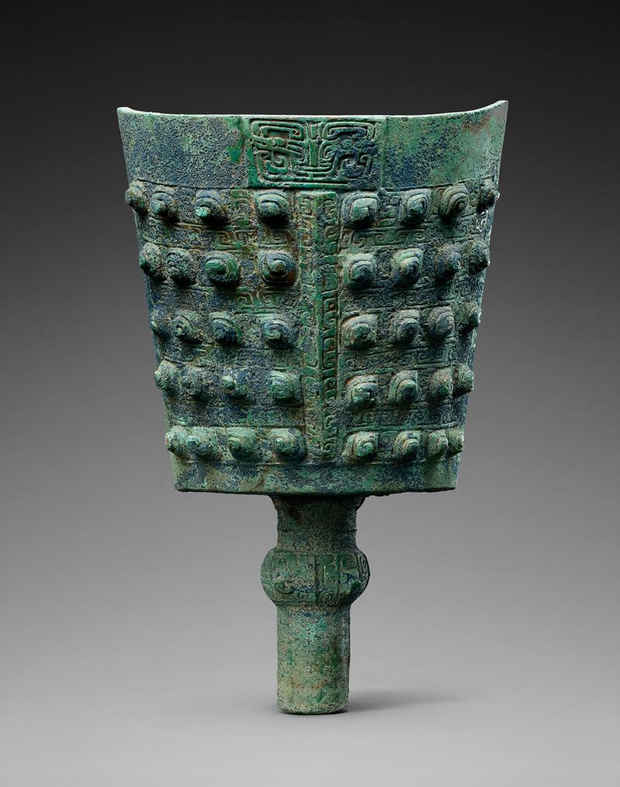“Masterworks from the Chinese Past” Exhibition
Gagosian Gallery Madison Avenue

[Image: Bronze bell, Nao, late Shang dynasty (ca 1600-1050 BC), bronze with green and blue patina, malachite and azurite encrustation, 22 10/16 × 14 1/2 in. Microanalysis ASA. Swiss private collection. Courtesy of Gisèle Croës. Photo by Studio
This event has ended.
On the occasion of Asia Week New York, Gagosian Gallery presents “Masterworks from the Chinese Past” in collaboration with Gisèle Croës Arts d’Extrême-Orient. Belgian connoisseur Gisèle Croës has been collecting Chinese antiquities for forty years. She has collaborated on exhibitions with Gagosian Gallery since 2014 in New York and Hong Kong. This exhibition will include rare and important works spanning the Neolithic period to the Qing dynasty.
Among Croës’s selection is a group of five ancient Longshan black pottery stem-cups. Harking from the Neolithic period (ca 3000 BCE), the eggshell-thin vessels are astonishing testaments to early innovation in ceramic technique and technology. A bronze Gu vessel (ca 1100-1000 BCE) and a double-owl You vessel from the late Shang dynasty (ca 1600-1050 BCE) display visual narratives of metamorphosis. From the same period is a bronze Nao bell, incised with the traditional taotie and lei-wen patterns. Bells of this type were among China’s earliest percussion instruments; in southern China, these large chimes symbolized the power of the local aristocracy and were often regarded more highly than bronze vessels. A collection of bronze weapons and tools from the Shang dynasty, including a dagger, a bronze bow-shaped fitting, a ladle with a dragon design, and an axe, show acute attention both to form and function.
More overtly glamorous is an extraordinary set of four imperial throne chairs from the late Kangxi period (ca 1720-30 CE) with gold-etched qiangjin lacquer. Of equal intricacy but on a small scale is a collection of gold pieces generated between the Jin dynasty (ca 265-316 CE) and Tang dynasty (ca 618-905 CE). An ensemble of thirteen gold ornaments inlaid with turquoise served as official insignia during the Tang dynasty, and suggest the cosmopolitan aspirations of the era; while an elegant bronze mirror from the same period, decorated with a mother-of-pearl dragon on a malachite mosaic ground, highlights the sophisticated craftsmanship of the illustrious “Golden Age.”
By contrast, two serene Buddhist Guanyin sculptures emerge as focal points within the exhibition. Guanyin, the Chinese incarnation of Bodhisattva Avalokiteshvara, wielder of universal compassion, demonstrates close ties between religion and China’s sculptural traditions. The expressive wooden version from the Liao period (ca 907-1125 CE) and the stone carving from the Song dynasty (ca 960-1279 CE) reflect a representational convention unique to China: the figures are female. An exquisite set of figurines of female musicians and dancers, a favorite genre of the Tang dynasty, bridges the regal and utilitarian pieces within Croës’s curatorial selection. Beyond their supreme artistic achievement, each of these special works represents a wealth of cultural and historical contexts inviting deeper investigation.
For the past forty years, Gisèle Croës Arts d’Extrême-Orient has promoted the understanding and appreciation of Oriental Art. Since 1976 Croës has participated in the European Fine Art Fair, Maastricht; the international Asia Art Fair, New York; and the Biennale des Antiquaires, Paris. Knowledgeable, well-designed catalogues accompany her exhibition program. Between November 2015 and January 2016, Gisèle Croës collaborated with Gagosian Hong Kong on “The Shape of Time,” a presentation of exceptional Asian antiques with modern and contemporary works.
Media
Schedule
from March 10, 2016 to March 19, 2016
Opening Reception on 2016-03-11 from 18:00 to 21:00